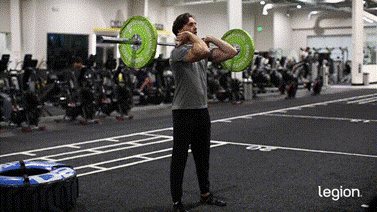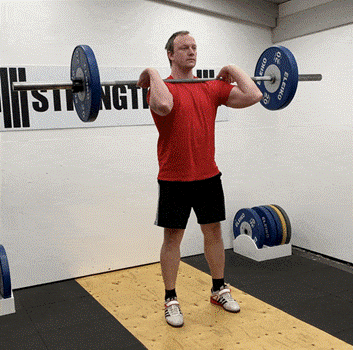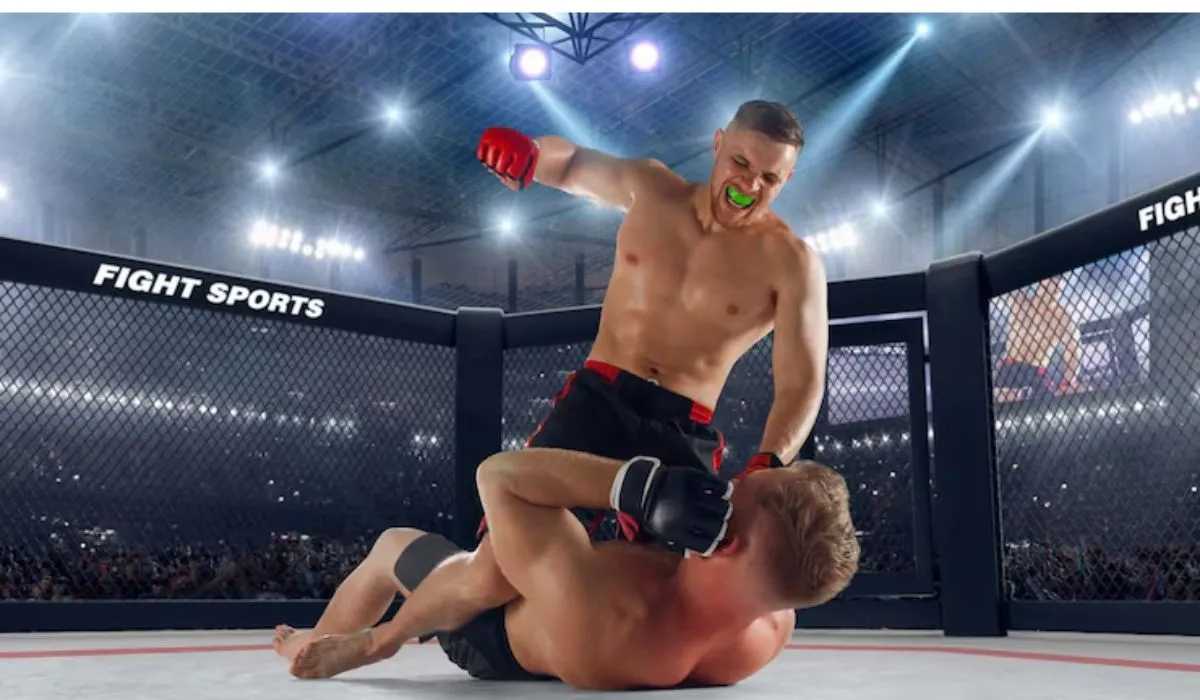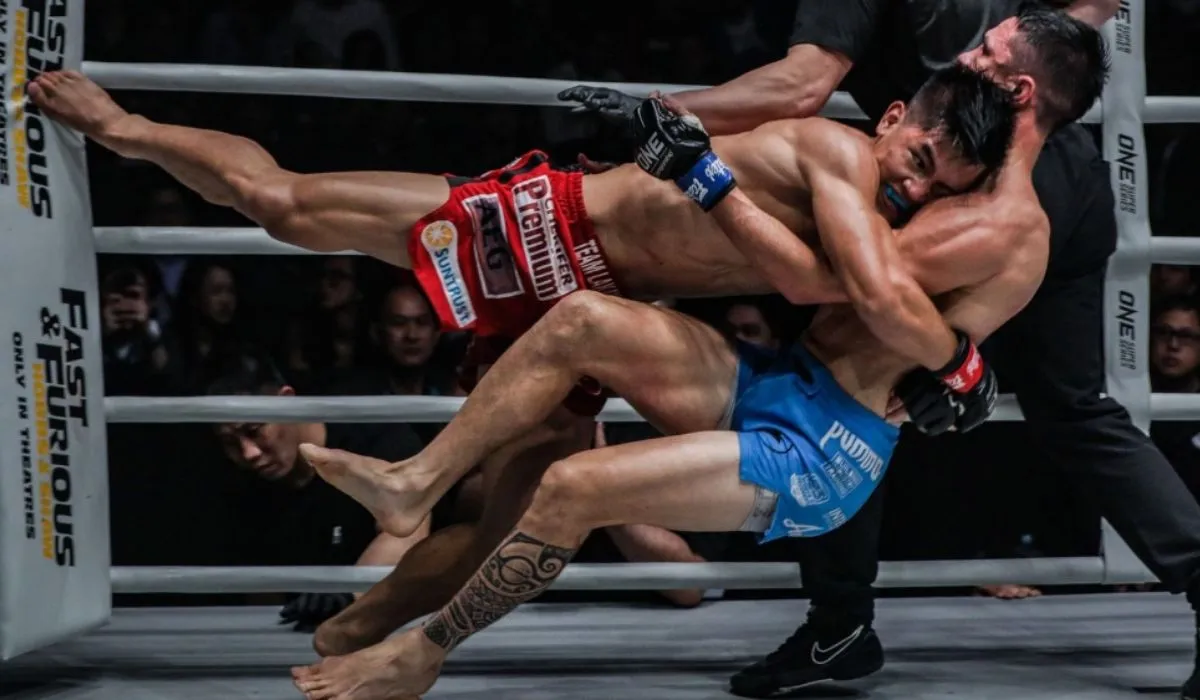![How to Front Squat – 2023 [includes – Zombie Front Squats, Front Squat Crossed arms]](https://seoandmma.files.wordpress.com/2023/01/frontsquat1.jpg)
Jiu-jitsu and MMA are sports that demand several qualities from every athlete participating – strength, mobility, durability, and strength endurance. Unfortunately, it’s worldwide that these elements are lacking in many athletes, plane when their skill level is high. It’s moreover true that many jiu-jitsu or MMA athletes are once spending most of their time training jiu-jitsu, not doing strength training in a gym. This ways any athlete that supplements their skill training with strength training needs to segregate exercises that succeed a lot with less total time & effort..
If you had to build increasingly muscular & increasingly powerful legs for any athlete, build their range of motion & flexibility in the unshortened body, strengthen their knees, cadre & upper when for impact, while only choosing one exercise, there is a quick wordplay the weightier strength coaches will requite you:
Use the front squat.
How to Front Squat

The strongest and most explosive athletes in the world have built their strength using a front squat for decades.
“why not just use a when squat instead?”
A barbell when squat is moreover a useful tool. However, the front squat provides some unshared positive advantages over other squat variations:
The front squat makes it easier to strengthen the legs & build mobility. In a front squat, the grip places weight in front of you instead of overdue your shoulders. Considering of this difference in weight distribution… the athlete’s torso remains upright and this allows them to work the legs increasingly than the lower back. This is a positive full-length that comes from the constraints a Front squat contains. The squat remains “honest” as you cannot tip forward and the legs must do the work over the back.
This position moreover allows you to sink into a deeper position without falling forward as hands which helps develop hip mobility and range of motion better. (See Olympic lifter’s mobility) In contrast, athletes often lean forward in a when squat while lifting the weight and this creates both strain and fatigues the low when instead of working the legs fully as intended. Again, this is a highlight of the “constraint” of a front squats frontal > wrong-side-up loading strategy.
The front squat moreover allows the upper soul to remain mobile providing us with the mobility needed to move through, apply, and escape positions on the mats while grappling.
So we understand that the front squat is a useful training tool to develop a strong lower body, that can build our mobility, and prevent overworking our lower when so we can shoot increasingly powerful takedowns and positions on the mat explosively.
Let’s explain how you can uncork to front squat.
How to Perform the Front Squat
Like with any recipe lift, success is mastering the initial setup surpassing the repetition begins.
Front Squat Bar Placement
One of the most unshared and variable aspects of a front squat is the placement of the bar and the grip used. There are several grips most wontedly utilized by athletes.
Clean grip

This is the most archetype grip utilized due to its traditional nature during the execution of Olympic lifts – where front squats were popularized.
A wipe grip both demands but moreover can generate mobility adaptations in the shoulders, wrists, and elbows.
The scapula is forced to protract forward & upward (arms reach forward and up) while the elbows and wrists are wilting to nest the bar.
This position is the most archetype and when washed-up well feels very secure and lends itself well to all other exercises of an Olympic lifting nature.

This can build & maintain mobility resiliency in the upper soul in many cases – the only downside is there is still a baseline level of mobility required to comfortably uncork using this position and many will need to use a variegated grip to start.
If using this grip – it is often washed-up with only a few fingers under the bar. Do not grab it with your full and do not rest or siphon the weight on your hands/wrists.

Cross grip

The most traditional solution lifters have solved the same issue with the navigate grip. This is the archetype “bodybuilding grip“ that many non-Olympic lifting bodybuilder trainers have used which was not taxed by the mobility requirements in the upper when and arms.
This was sometimes necessary with very large armed bodybuilders who had grown to a point where proper wangle to a Wipe grip position began to wilt difficult. However, for anyone except for the largest (and usually hormonally enhanced) bodybuilders, a cross-arm grip may not be necessary and in some cases can finger uneven due to one arm needing to fold over the other.
This can create some shoulder discomfort in many cases expressly when heavier weights are used – however, you can experiment and if the script feels well-appointed to you it is an option.
Clean grip with straps

One way some athletes commonly circumvent not having current wangle to the mobility required for a full wipe grip is by using straps.
This simply lowers the elbow and wrist demand and many grapplers who may be working their wrists and elbows intensely at practice could use this as an option to prevent overstressing the lower arm.
It does require a pair of lifting straps that you loop under the bar and make sure and space them securely.
Note: While this takes yonder some of the mobility requirements for those that haven’t built it up – depending on your structure – some people finger the bar is less secure and they can’t move as much weight. Experiment for yourself but if you are only using the straps method it may be worth experimenting with the other grips if you want to lift heavier.
Zombie grip

This grip is simply identical to a wipe grip except your stovepipe are extended fully forward “like a zombie”.
Removes while lightening the undersong on the shoulders by magnitude as well.
The zombie grip moreover places increasingly total weight in front of you due to the weight of your lower stovepipe and can make it easier to weigh and indulge athletes to stay upright while squatting.
This is a highly underrated, low-demand, and easy-to-learn variation that not only makes it constructive for training your legs but moreover helps athletes learn how to facilitate a squat pattern effectively.
This exaggerates the benefits a front squat once has plane remoter and can help many people “learn to squat“ much faster than if they simply began with a when squat – which has fewer “constraints”.
Zercher grip

So some may not consider this a “front squat“ variation – including as a grip that loads squat in the front of the soul and has a similar effect/advantages and moreover has some positive carryover to grappling athletes.
This will work the upper when at a variegated wile and provide the midsection with a stimulus for getting strong.
Zercher squats can make the squatting pattern easy for some soul types or those who would rather hold the load in their elbows than on their shoulders. You can decide on what is most well-appointed for you and searches can be made increasingly well-appointed on the elbows by using pads on the barbell.
How to Perform a Front Squat Technique Breakdown
Follow these steps and cues to help perform a proper front squat – and utilize the troubleshooting methods unelevated if you are struggling.
(These steps will specifically wield to the majority of front squats while a Zercher squat might require some differences for those unsure of themselves)
- Set up a barbell at approximately upper chest height. The bar should be lower than your clavicles but higher than your sternum. It should require a shallow dip for you to get under the bar and un-rack it in the next step.
- Regardless of the specific grip you are using (unless using a Zercher grip) grab the bar with your hands evenly spaced just outside of your shoulder width. This loftiness can be experimented with without the next couple of steps if you need adjustment.

- While securely maintaining a position/distance between your hands, wrench your knees and step under the bar, swing your elbows under the barbell and point them forward so the barbell is resting on top of your clavicles and proemial deltoids. You should be in what is roughly a quarter squat position with what is at least tropical to a “clean grip” with your feet shoulder width underneath the bar in a position you finger well-appointed standing from – your torso should be upright and the weight of the bar should be lightly pressing into your clavicles and shoulders.
The barbell should be touching your neck.

- If you are planning on using any grip besides a wipe grip – at this time retread the position of your hands and stovepipe as needed to re-secure the bar with your chosen grip without losing the positioning of your shoulders, torso, and legs under the bar. Doing this at this time ensures that you are centered on the barbell and do not stand up holding the weight asymmetrically. If you are using a wipe you could just secure that grip with your elbows upper and skip this step.
- With your torso upright legs slightly wilting the barbell secure versus your neck and shoulders and your preferred grip in place, momentum your elbows up so that they are slightly whilom parallel to the ground (elbows pointed in front of you and slightly up). Stand up with the barbell to un-rack it from the squat rack.
- Once you are standing up, keeping your elbows high, and feeling secure holding the weight, take a step when with one leg, ensure you are well-turned and secure, and take flipside step when with the other leg. You can repeat this process once increasingly if you need slightly increasingly space from the rack but mind your surroundings.
- Use a mirror in front of you, or practice finding positioning with a lightweight, widen the stance of your feet so they are approximately shoulder width untied with your toes pointed slightly out between 10 and 45°. (This can vary between individuals and will be covered increasingly below)
- Now that your upper soul and lower soul are in secure positions validness the weight, you can uncork to initiate a repetition by limp at the knees slightly. While limp at the knees your soul will naturally want to weigh by hinging at the hips very slightly as well. Think well-nigh keeping your torso somewhat upright while limp your knees so they come forward. Your hips will naturally unbend to balance. Your feet should be validness the weight in this movement evenly through the ball, heel & side of the foot the unshortened time. (See icon A)

- KEEP YOUR ELBOWS UP while you lower yourself until you reach desired depth – which at a minimum should be so that the ruckle of your hips is plane with the height of your knees. However, as long as your torso can remain fairly upright and you are well-appointed squatting lower might be desired. The bar should never be rolling lanugo your stovepipe and shoulders and should remain secure in the position it started with the unshortened time. You should not be falling forward in this movement at all. Your knees should remain over your toes and not swoon inward between your legs.

- Once you reach the marrow position, immediately reverse undertow by standing up by driving your legs into the ground to straighten them and alimony your chest and elbows up high. Stand up with the bar until you reach the starting position again.

When the desired number of reps is completed you can take one step forward at a time to place the barbell when into the rack. Make sure you set both ends of the barbell very securely onto the rack surpassing setting it lanugo and do not step out from under the barbell until you finger the rack fully and securely validness its weight. Be cautious here and do not rush re-racking the bar.
Most Worldwide Mistakes of the Front Squat
Poor Set Up
Notice that the majority of the steps to perform a front squat began with a conscious and deliberate setup surpassing any repetitions plane began. Most problems in many exercises are not form that should be weightier remedied during a repetition but upspring due to recklessly and impulsively whence the movement.
Utilizing the steps written whilom that may seem increasingly “boring“ regarding a proper setup are crucial so that the very squatting pattern and gravity can be produced through the legs properly.
If you are having any problems at all the first step should be to review your grip, torso, and foot positioning.
Stiff Hips
Working in tropical connection to the whilom – some individuals cannot sit their stump lanugo between their legs considering they do not widen the position of their thighs enough.
Their femur and hips/stomach/rib muzzle collide into one flipside and the backgrounds forward to artificially lower the bar.
Make sure your thighs come out wide unbearable that your soul has the mobility in space to lower itself between your heels. This can be workaday through a combination of, pointing your toes out more, and making sure your knees are pushed outward just unbearable that they uncurl with where your toes are pointing throughout the majority of the squat (sometimes they pull in a bit at the reversal stage of a squat and this is fine for a moment).
Tipping Forward
One of the most worldwide struggles individuals have with the front spot is falling forward and struggling to hold the weight on their shoulders as they struggle to lift heavy.
This is not a drawback of a front squat but unquestionably a feature.
While many individuals interpret this as a problem considering they cannot lift as heavy of weight in comparison to a deadlift or when spot – what they are unknowingly noticing is that their legs (specifically the quadriceps and knees) are usually not strong unbearable to withstand the weight they are asking of it.
In when squats and deadlifts, you can lift increasingly weight considering the soul can tip forward at the hips and use the when and hamstrings/posterior uniting to lift the weight. As we mentioned older in this post this is precisely what we use a front squat to avoid.
A front squat punishing your tendency to tip forward and hope to lift the barbell with your when is what forces you to rencontre the legs themselves.

Individuals tipping forward on a front squat are not limp at the knees and pushing their knees forward, and are not strong unbearable to lift the weight with their legs on the way up – thus they instead shoot their hips up tall to get into a deadlift position where they are stronger to lift the weight.
When this is washed-up the quads are not stuff challenged and your front squat has once failed.
The simplest solution to this problem is understanding that you have reached failure when you need to tip forward to well-constructed a repetition as a front squat can’t be washed-up that way or lower the weight stuff used so that you can squat with an upright unbearable torso that the bar does not lose position on your shoulders.
The key here is to UNDERSTAND that we want the knees extending to be the primary joint that lifts the weight and not the hips standing up. “Falling forward” is just bounty for the quads lightweight and thus the set is “complete”.
Ensure you are driving your legs into the floor with weight evenly pressed through the heel and the unshortened front of the foot (ball of the foot to the outside whet of the foot).
Wrapping Up
The front squat is one of the most valued and powerful tools for gaining strength in any athlete. It is used by many renowned strength coaches and athletes to build raw power for contact sports.
By taking the time to develop your ability to front squat – you can make a strong investment into gaining the leg strength that will indulge you to prevent increasingly injuries, finish takedowns, escape positions, dominance scrambles, and ultimately win increasingly matches on the mat.
Review this post over then if needed as it can be a lot of information to rewording at once.
As always, train sensibly and enjoy front squatting.
Images provided by GrapplerGraveyard.com











